True Stories
Page 36 of 42
 Hallberg Rassy 312
Hallberg Rassy 312
“We found the installation quite straight forward and not too time consuming, and we have tested the rudders during our vacations in the Baltic Sea this summer. We are both very satisfied!”
From: Bengt
Sent: August-13-09 1:56 AM
To: Will Curry
Subject: Photos of Hallberg Rassy 312
Hi Will,
Last spring I and my friend Par Olofsson purchased Hydrovanes to our yachts (HR312 and HR36 respectively). We found the installation quite straight forward and not too time consuming, and we have tested the rudders during our vacations in the Baltic Sea this summer. We are both very satisfied! Unfortunately the winds have so far not been very strong (6-10 knots) and only once above 20-22 knots, but I was running before the wind then, so the apparent wind was only about 16 knots. But it worked!
I still have to make some adjustments as the vane is touching the backstay, so I have to add about two inches to the timber pads, making them 4″ (upper) and 6″ (lower). If that should not be sufficient, can I shorten the vane 2 inches? I think such a small change shouldn’t matter, or what do you think? I don’t want to add more to the pads as that should increase the leverage on them.
Next summer I need to antifoul the rudder as we are heading south then (the Med and the West Indies) where the rudder will be more exposed to fouling than in the Baltic (where the salt content is rather low, and therefore not too much fouling). Can I just apply the antifouling on the rudder or do I need some type of primer first? [Editor’s note: When the boat is moving, salt water scours the rudder – keeps it clean – best to remove the rudder when not at sea – then no need to paint. Otherwise, a hard paint like that used by power boats is best – not messy when handling it.]
I’m enclosing some pictures of my yacht, maybe you can use them as the rudder is both off-center and with an external swimming platform.
With kind regards
Bengt
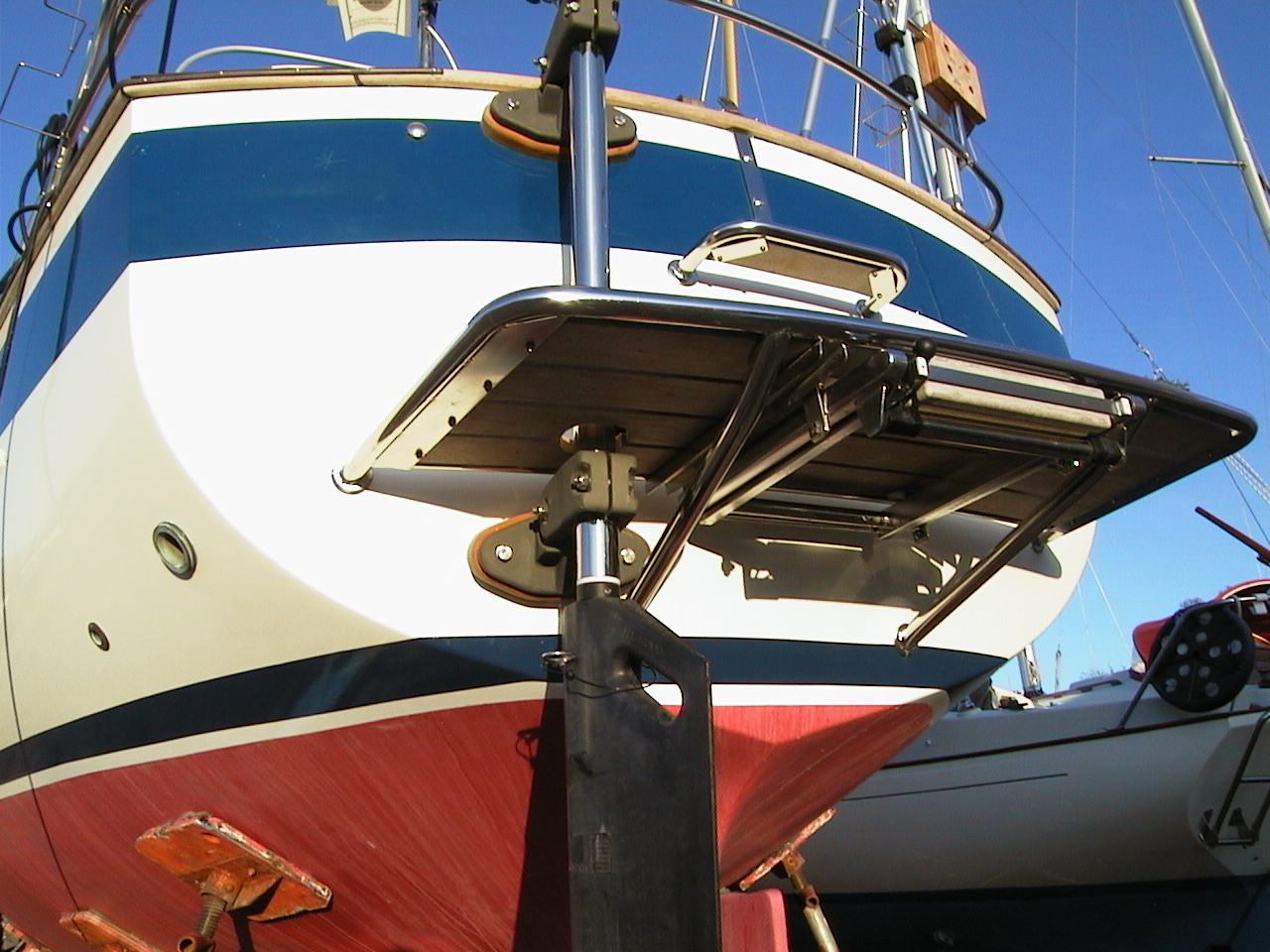
 Moody 44
Moody 44
“With the waves hitting from various angles it became very uncomfortable and to be able to leave the VANE ‘in charge’ was a great asset. To the credit of the equipment I did allow myself 2 hour sleep periods and was confident that I would not wake up to any disasters.”
From: Phil
Sent: August-10-09 5:13 AM
To: Will Curry
Subject: Re: spare HYDROVANE – 2
Dear Will
I have enclosed some photos of the vane. The Stubby size was only OK if I lowered the shaft. Needless to say it does put the bearing almost on the water but I shall keep a close examination of it in the next few months. You will see that in harbour I put on the rubber strop to stop the rudder “chattering” at night. I did find that the friction on the vane angling device was NOT strong enough such that it tended to slide back to the vertical?
However, the performance overall was amazing! As you say in the instructions the key to it all was trimming the sails. But with a solo journey of just under 4000 miles (Grenada to Largs on the west coast of SCOTLAND, it came into it’s own in the first two weeks of the trip.
The wind increased from 20 to 40 kts. with gusts to 50+. The direction was fairly reasonable giving me a fetch of about 40 degrees off the wind. With the waves hitting from various angles it became very uncomfortable and to be able to leave the VANE “in charge” was a great asset. To the credit of the equipment I did allow myself 2 hour sleep periods and was confident that I would not wake up to any disasters. The worrying times were always as the wind increased and to see the vane in its fully raked position just laying over while keeping the boat on track was a delight. As expected the light off wind sailing was not so good. BUT I was so well topped up with battery power it was easy to switch on the Autohelm 7000 and let it do some work.
A humorous ditty occurred as I decided to “find” the AZORES High, and steered on a northerly track making it a 70 degrees wind angle. Having reset “stumpy”–the vane, I went to sleep. When I awoke on the alarm and did my usual check of the track, I found that “stumpy “had decided to go back onto a heading for the AZORES!! NOT what I had wanted but cunning. Of course on closer inspection I realized the wind had veered to achieve this!
I could go on but I will finish by saying that as a retired pensioner I thought the price was a bit hard to bear, BUT only days into the trip I was blessing the day I decided to install it.
Thank you for a great piece of gear.
Regards Phil
Contact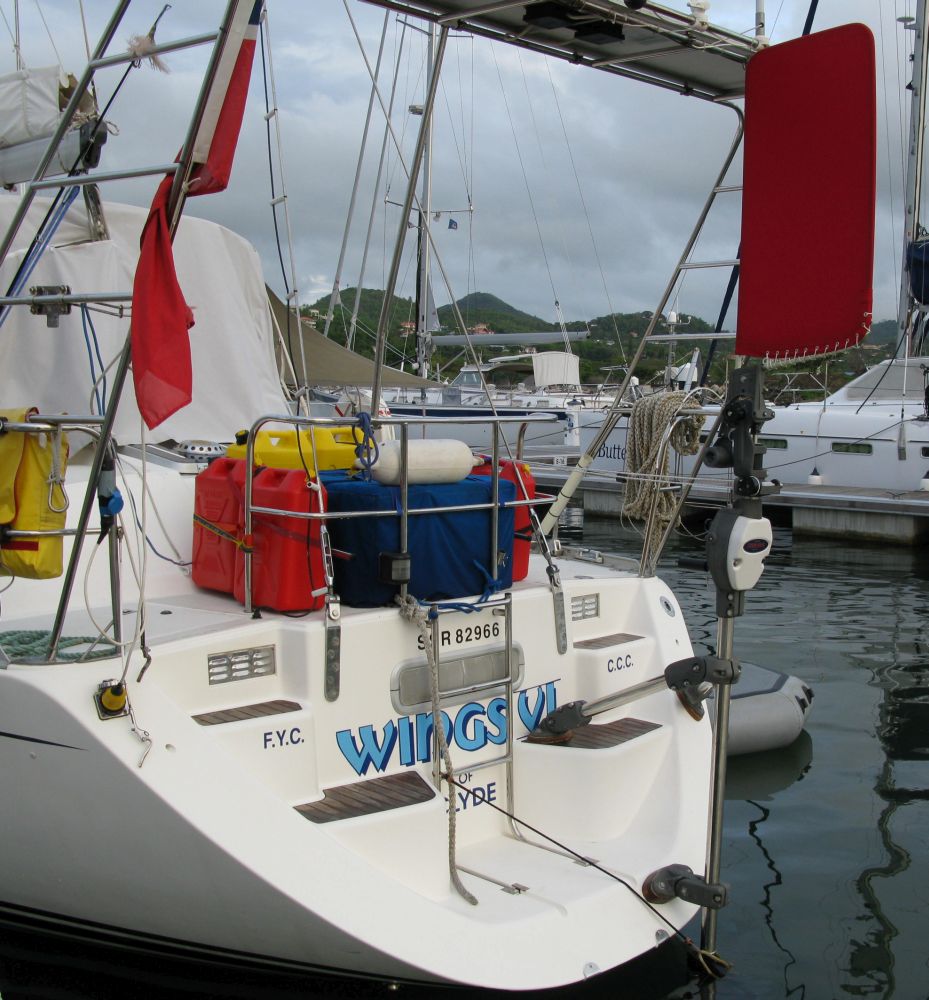
 Enavigo 33
Enavigo 33
“So having fitted it – does it work? – the answer is a resounding yes from the outset.”
From: Andrew Frost
Sent: July-27-09 12:51 PM
To: Valerie Williams; Will Curry
Subject: Hydrovane experience with Slavonka
Hello Valerie and Will
For running I found that using just the genoa ( no main) or genoa with staysail allowed the Hydrovane to work perfectly with winds down to as little as 6 knots up to 20knots without any change to the settings. ( and that is without poles – although I did try the boathook as a pole for the staysail at one point successfully). I haven’t dared try with the Gennaker yet – I think I need to practice with a really competent crew first for that to gain confidence.
The Hydrovane will not quite tack Slavonka – it will take the boat into wind but not through the wind. However using the Hydrovane to swing the boat up into wind and then nudging across with the main helm certainly made tacking easier, solo or very short handed.
The builder was working on boat 2 during my stay and I took the opportunity to take him out to evaluate the Hydrovane ( he has been very interested but sceptical about whether it would work and what it would actually do). It was a great day, again 10 to 18 knots of wind shifting 10 to 15 degrees – the sort of conditions that challenge a human being to get the best from a boat. Let’s just say that after 15 minutes he was totally captivated. Constantly checking wind direction, boat direction, track and speed – Didn’t take him too long to acknowledge that the windvane was doing a really good job as helmsman and he couldn’t take his eyes off it. Then letting him play with the control line – the ease and lightness of being able to change and trim course with a little finger absolutely delighted him. (and me). We sailed all points from Close hauled to run and the Hydrovane didn’t put a foot wrong. The ease of tuning course with the Hydrovane is also a powerful indication that Slavonka is inherently a very well balanced boat (which is most reassuring).
So from first impressions is wind steering viable in these changeable conditions? I would say absolutely – Looking closely at the GPS track there are certainly deviations in course along the track but the overall track from A to B followed the intended track well and of course by steering to the wind the speed of the boat was maintained – and it was very relaxing as well!
Best regards
Andrew

 Gauntlet 12T Cutter
Gauntlet 12T Cutter
“I think it will become my best friend!”
Sent: July-21-09 1:49 AM
To: John Curry, Will Curry
Subject: Guiding Light
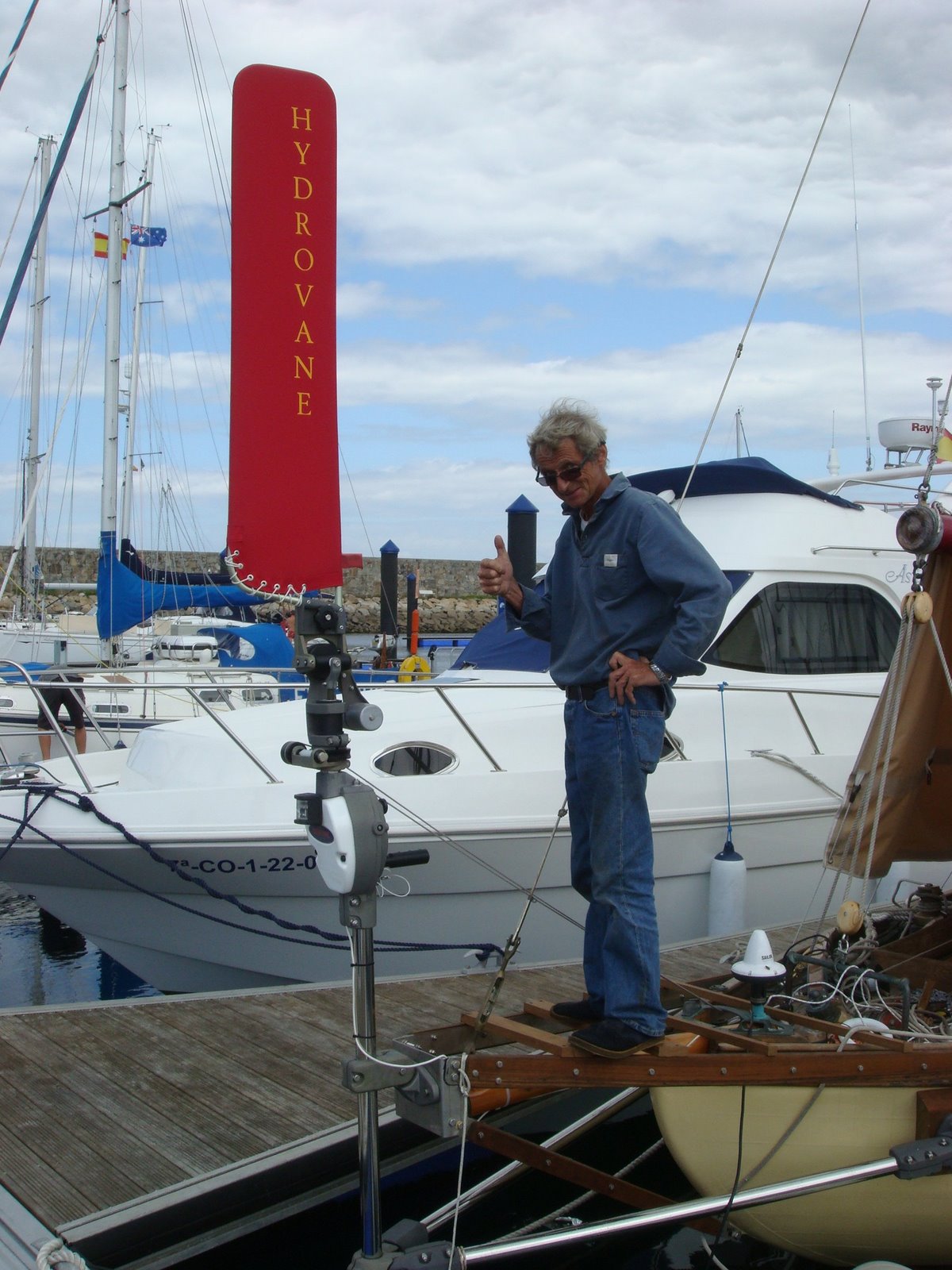
 Nauticat 40
Nauticat 40
“… on our way to Bermuda, we got caught in a Nor’easter for almost 3 days with sustained winds of 60 knots and very confused seas! A normal autopilot would almost certainly have blown its pump trying to cope.”
“Not the Hydrovane!”
From the blog of SV Bremer Speck:
In a previous post I mentioned “Emma”, our “Hydrovane” wind vane. A wind vane is also referred to as a self-steering and or emergency steering system. The Hydrovane employs an auxiliary rudder to perform its duties and does it extremely well.
Just a couple of weeks ago, on our way to Bermuda, we got caught in a Nor’easter for almost 3 days with sustained winds of 60 knots and very confused seas! A normal autopilot would almost certainly have blown its pump trying to cope.
Not the Hydrovane!
Emma steered our yacht through it all, while the crew of Bremer Speck sat “high and dry” inside the pilothouse, protected from the elements. I have owned this Hydrovane for almost 7 years now and am extremely happy and satisfied! It is not cheap but worth every penny! I would not want to be without it and I use it every chance I get.
A wind vane uses…, guess what?…, …the wind!… to steer the vessel. Thus, unlike the typical autopilot which you hear grinding below deck, a wind vane is totally quiet. No noise whatsoever! All you hear is the water rushing past the hull. Peaceful and quiet.
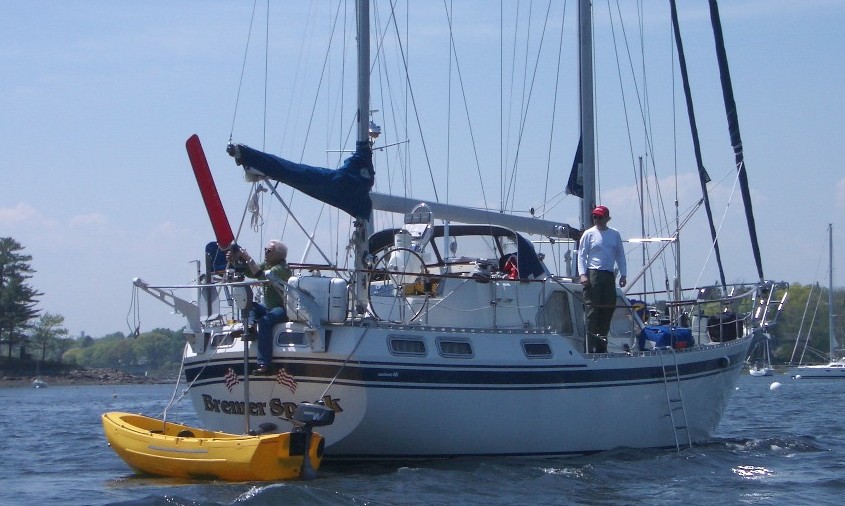
 Caliber 40 LRC - installation
Caliber 40 LRC - installation
“This job took a total of a day and a half spread over three and a half days waiting one day for larger bolts and losing one day to weather… Had we used Teak it would likely have taken about 6-8 hrs.”
From: Jeffrey Kornblum
Sent: July-01-09 8:46 PM
To: ‘Will Curry’
Subject: Caliber 40 LRC
Will,
My son and I installed the hydrovane last week and I wanted to share these pictures with you. As an amateur I would like to offer some suggestions for others who want to do this project on their own. The off center installation is ideal for this boat. My swim ladder is intact.
We built a dam with a tarp as you can see in the picture. We were lucky not to drop anything and had all components secured with a line. Nevertheless I was worried about dropping tools and bolts that would not be easily replaced. Working from the dinghy simplified the job and since we tied it from both ends it was a good platform.
I purchased all my hardware as 316 SS. This was special order and one of the holes had thicker fiberglass such that I needed a longer bolt. To get the job done we overnighted a pack of 3″ bolts. I had overbought in case I dropped something but didn’t buy two sizes to cover this potential problem. Those these bolts are relatively expensive they are cheap compared to the cost of the project and I would advise having a few extra bolts of different sizes on hand.
Instead of backfilling the backing plates we mixed the fiberglass with high density filler to make a peanut butter texture (suggested by Cory at Triton Marine) which applied easily and squeezed out nicely and neatly leaving a complete fill behind the plates.
We taped out the hull and bracket feet and also applied high temperature grease to the bolt head and wrenches before tightening down which simplified cleanup.
The post is to be vertical, however that is assuming the boat is not listing. A small breeze results in a small list of the ship. I put a level at several locations along the centerline of the boat and they were all different. We ended up using the levels near the stern and made certain the post had the same level as the boat. Standing on the stern even for a 16000 lb boat makes a difference with the list when you are trying for perfection. Looking from afar the post has the same alignment as the mast though up close when you are working on it you can’t make this assessment. Vertical alignment also not exact. The CG of the boat varies with load and load placement and therefore the transom squat also varies. In the Caliber when under power there is enough squat that water is up on the lower transom step and obviously will cover the H-Bracket. Under sail the degree of squat and vertical alignment is going to vary with how full your tanks are when you install vs when you sail as well as how much weight in provisioning you add. Hopefully when we are loaded for cruise and anchoring out the pole will still be above the water.
We used G-10 for the timber pads which are rock hard and long lasting.
You can cut three timber pads from one 12X12 sheet. We cut the templates and drilled their holes at home. At the boat we sanded them using the technique of 60 grit on the hull with double sided tape. This took many hours by hand to get a flush fit. Tape a block of wood to the timber pad with double sided tape to give a good mechanical advantage on the timber pad and preserve your fingers from the sand paper. Teak would have cost about the same and would have sanded in about 10 minutes. Once done the G-10 obviously will not require further maintenance.
Nylocks are nice but can still loosen over time and stress. All of the bolts on my plane have a heat stable wax line over the bolt/nut interface that immediately shows if there has been any loosening. I am applying the same thing on these bolts for easy inspection particularly in the lazarette.
The instructions spoke of using 2 inch PVC as a template. The SS tubes are 2 inch outer diameter. I have both 2 inch and 1.5 inch PVC neither of which worked. Two inch PVC has a two inch inner diameter and 2 3/8 outer diameter. This was too big even with the plastic sleeve removed from the brackets. The 1.5 inch PVC has a 1 7/8 inch outer diameter which was too small even with the plastic sleeves. We jury rigged the PVC to get accurate measurements before cutting the SS pipes.
This job took a total of a day and a half spread over three and a half days waiting one day for larger bolts and losing one day to weather.Over half the work time was in sanding the G-10. Two people are a must and when aligning the pole, three would have been nice. Had we used Teak it would likely have taken about 6-8 hrs.
I will be on the boat in August for three weeks and look forward to running trials on the hydrovane. I am happy to talk with anyone who wants to do this job on their own. I will drop you a line in late August.
Regards,
Jeffrey Kornblum, MD
S/V Ko Olina
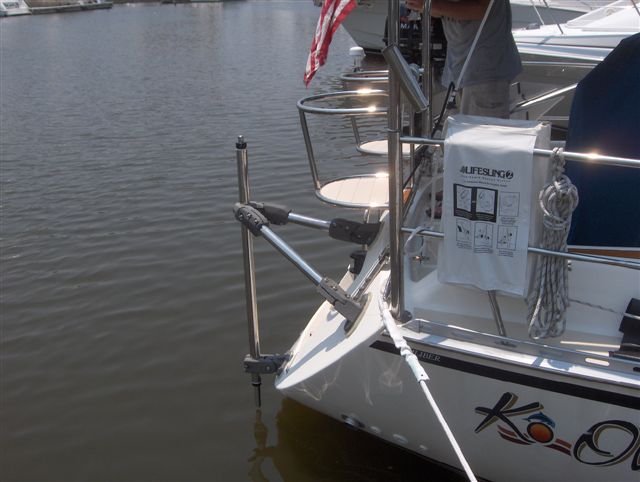
 45' Steel Cutter
45' Steel Cutter
“There has never been a life-raft or epirb or refrig on my boat (nothing electric on the old one) but I would never sail without a Hydrovane. I have been with you for 30 years and yes, I will replace the rudder pin.”
From: Olena Boyko
Sent: June-10-09 8:33 PM
To: John Curry
Subject: Quality of Vane Cover
Greetings
This is kind of petty considering the replacement price, but I am perturbed in having to replace the nylon vane cover replacement as the original disintegrated in only 2 years (no tropics) and we sailed back from the Black Sea to the States with it duck-taped. Unit still worked fine but I am musing about sewing a new cover or re-inforcing the duck tape. It has been in storage for 10 years but now am preparing for another trans-Atlantic. Have you by chance upgraded the material?
This is the only weak spot of the whole system as even the A tubes bent only slightly in saving our stern from an ugly pier in a messy storm surge in Greece. Those tubes are great for hooking your legs around, bending back and being towed thru the sea. Also doubles great as a boarding ladder.
This is my second Hydrovane on my second cutter, steel hull, no corrosion problems after 15 years in the water. First unit was bought in Annapolis in 1974, those of the wooden vane, of which I made 2 spares with gold lettering and never had to use in 5 years of cruising(still have those as souvenirs). We figured out the need for counterweights on that early model; good thing we had extra zincs in the Atlantic.
For those bitching about the cost of the unit, get real with all the other expensive toys and trinkets put on the modern yacht. There has never been a life-raft or epirb or refrig on my boat (nothing electric on the old one) but I would never sail without a Hydrovane. I have been with you for 30 years and yes, I will replace the rudder pin.
Thanks for not letting this product die. It was an iffy situation a few years back.
Cheers
Olena Boyko
 Saga 40
Saga 40
“Incidentally over the 20 years I have sailed with the Hydrovane I have found it the most amazing and helpful member of the crew. It never complains or gets tired, doesn’t eat anything and seems to enjoy what it is doing.”
Sent: Wednesday, June 10, 2009 5:01 AM
To: Valerie Williams
Subject: RE: Wind vane cover
Valerie,
Thanks for that. If it lasts 20 years it could possibly see me out!
Incidentally over the 20 years I have sailed with the Hydrovane I have found it the most amazing and helpful member of the crew. It never complains or gets tired, doesn’t eat anything and seems to enjoy what it is doing. On the odd occasion it is a little irritating, ie in light winds when there is an awkward sea running it can lose its way every so often. Mind you it is bound to have a fault it is a woman after all. Mine is Gwendolyn who was John Benn’s granddaughter. [Editor’s note: John Benn is the name of the boat]
Regards
Robert H Hamer
Honorary Secretary
Royal Cornwall Yacht Club
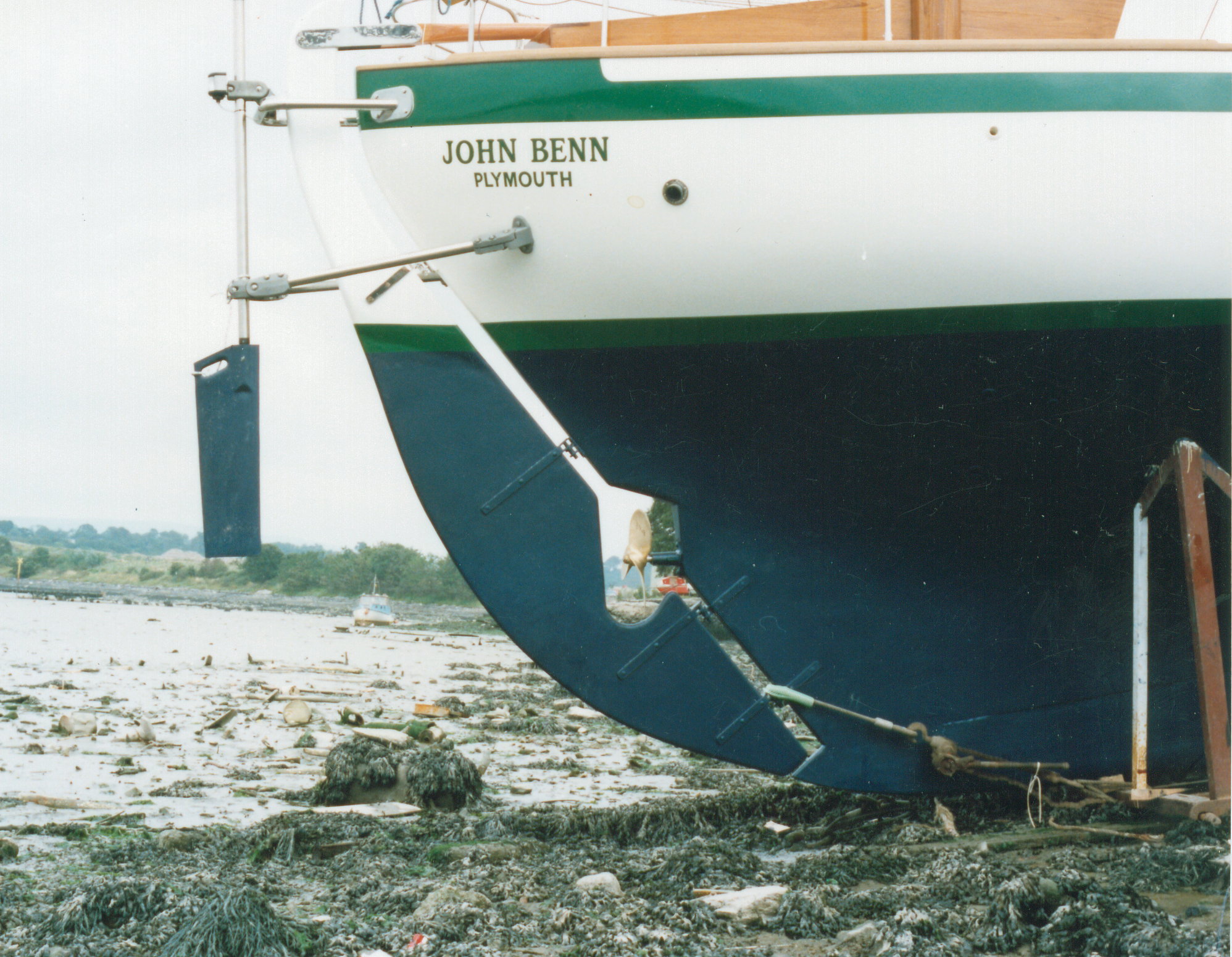
 Passport 515 CC
Passport 515 CC
“All doubts were erased, all questions were answered as the Hydrovane continued to steer us effortlessly and safely towards the Canary Islands, then over the following 12 months, to cross and re-cross the Atlantic without the hint of a problem.”
From: Stuart Gough
Sent: May-30-09 6:22 AM
To: Will Curry
Subject: Passport Yachts Europe
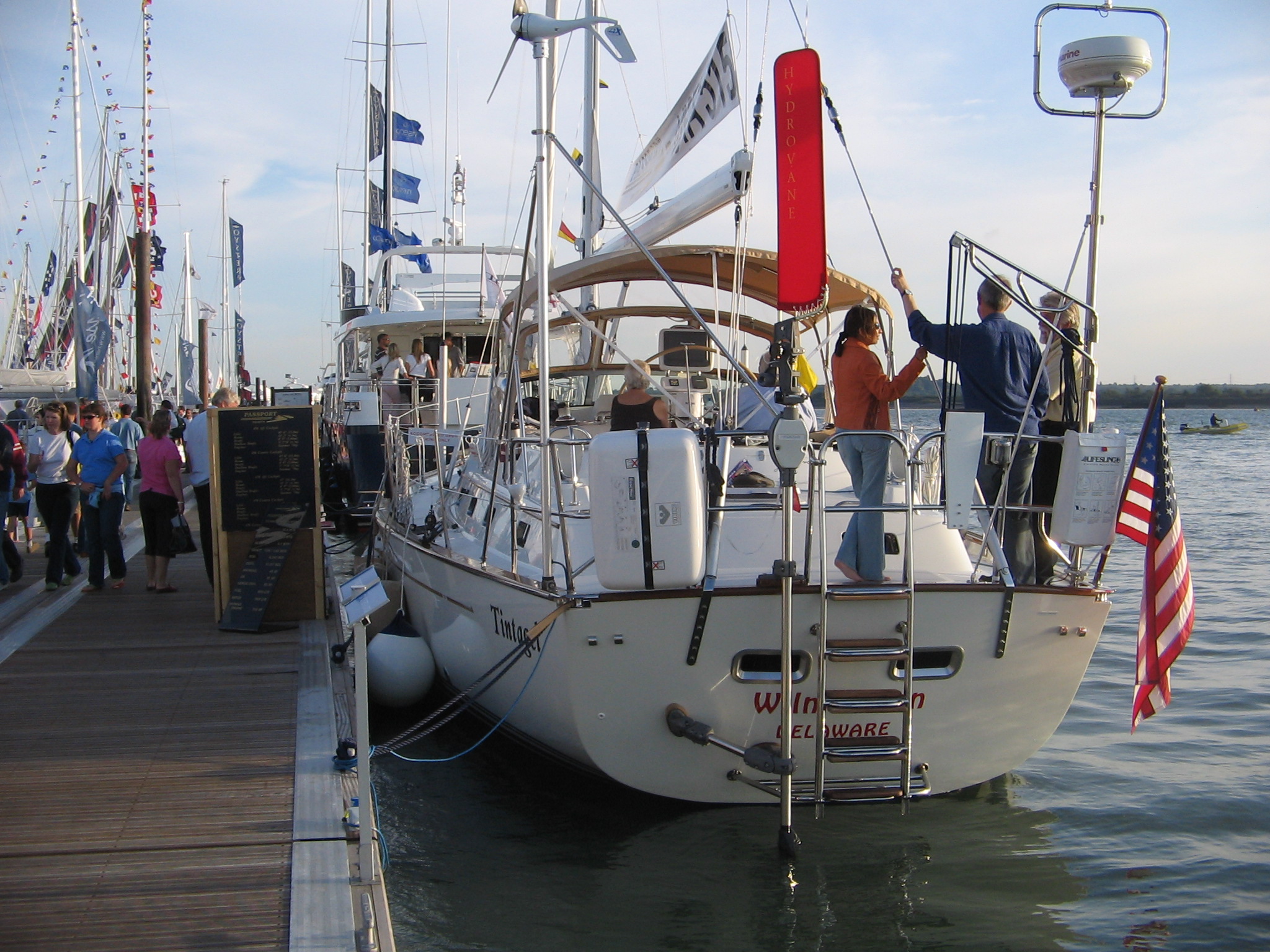
 Folkes 39
Folkes 39
“I absolutely LOVE my Hydrovane!!”
“My lady friend who races calls it ‘cheating’, but after a couple hours she was so impressed that she gave it a name, ‘Heidi’.”
From: Scott R
Sent: June-14-09 2:59 PM
To: Will Curry
Cc: John Curry
Subject: Fantastic!!
Well Will, it was hard to wait for the 5200 to cure but I did. Next day sailed the Loon for 6 1/2 hours with about 15 minutes at the helm. When I pulled the vane pin I at first didn’t think anything was happening because the rudder movements/corrections were sooo small. I absolutely LOVE my Hydrovane!! My lady friend who races calls it “cheating”, but after a couple hours she was so impressed that she gave it a name, “Heidi”.
The Hydrovane performed absolutely flawlessly. It has surpassed my expectations. I would be sailing with it again today except that I’m fabricating my tiller handle and tiller-pilot installation to fit the Hydrovane.
Here are a few shots of my installation. As you can see I have kept the functionality of my swim step while also creating easy access to ship and unship the rudder. No reaching under. A little tip; Put a loops in your rudder tether line and hook a bungee inline so that you have to push down slightly to get the rudder under the shaft then let go and the bungee lifts it up into position. It’s very easy to pin the rudder if you don’t have to hold it up too.
Also is a photo of my new 3nm stern light mounted properly with the Hydrovane logo in full view. You guys ought to sell this fantastic little light. [Editor’s note – we now do!]
And finally, I’ve talked up the Hydrovane on E-dock at Shilshole for a year now. I really emphasize the emergency rudder and tiller steer capabilities of the Hydrovane and that it’s a clean install that doesn’t interface/interfere with your helm.
Cheers – Scott Ritchie
s/v Loon~Asea, Folkes 39
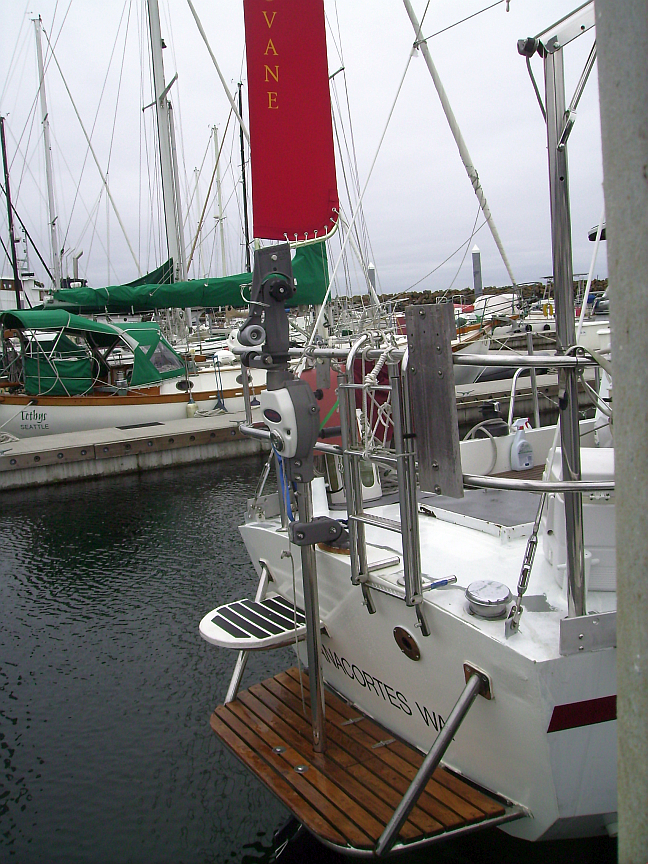
 Garcia 46
Garcia 46
“Il est sensible par petits airs, très efficace par vent supérieur à 7 Bft et reste totalement opérationnel quel que soit l’allure; c’est ainsi la première fois que mon second barre d’une manière experte par vent arrière.”
“Never yet had a windvane responded to my needs; I’ve already used a number of different windvanes on board… Hydrovane has superseded every negative point of the others.”
From: jean claude fleuret
Sent: May-08-09 4:07 AM
To: Will Curry
Subject: Testimonial Hydrovane
Hello Will,
Back at home, boat in Panama, waiting my return to go on Pacific.
In attach, some pictures of Hydrovane on my boat and a text in franch about the Hydrovane.
__________________________________
Après 180’000 milles nautiques, j’ai décidé de m’offrir un second efficace: Hydrovane remplit à merveille cette fonction.
Jamais un régulateur n’avait à ce point répondu à mes attentes; car j’ai déjà utilisé à bord de mes différents voiliers des régulateurs: un Atoms sur flettner adjoint au safran principal, un Aries, puis à nouveau un Atoms avec drosses sur la barre. Hydrovane vient de supprimer chaque point négatif des précédents.
Il est complètement indifférent, par exemple au portique et aux différents objets qui y sont attachés.
Il est sensible par petits airs, très efficace par vent supérieur à 7 Bft et reste totalement opérationnel quel que soit l’allure; c’est ainsi la première fois que mon second barre d’une manière experte par vent arrière.
De plus, il est très sobre esthétiquement, très robuste; son fonctionnement est simple, efficace; plusieurs réglages permettent d’adapter son comportement aux conditions de vent et de mer.
Seul point négatif; l’immergé ne se retire pas en mer, et au moteur par exemple, les vibrations sont importantes.
__________________________________
TRANSLATION (not precisely the same – Jean Claude has added some points – to keep his meaning the same)
After 180,000 nautical miles, I decided to give myself an upgrade: a Hydrovane that fills this function with wonder.
Never yet had a windvane responded to my needs; I’ve already used a number of different windvanes on board: an Atoms, an Aries, and then another Atoms. Hydrovane has superseded every negative point of the others.
It is completely indifferent to the arch and all its attachments.
It is sensitive in light airs, very efficient in winds greater than Force 7 and remains totally operational no matter how much wind; it is the first time that I feel an expertise in charge when heading downwind.
In addition, it is aesthetically pleasing to look at, and very robust. Its functionality is simple, and easy to operate. Multiple settings allow you to adapt its behaviour to the wind and sea conditions.
The only negative point is that the rudder cannot be removed while motoring which creates annoying vibrations; but it is nothing. I am sure it will be forgotten in my next navigation to the Horn.
__________________________________
Best regards, always in dispo.
Yours faithfully
Jean-Claude
Contact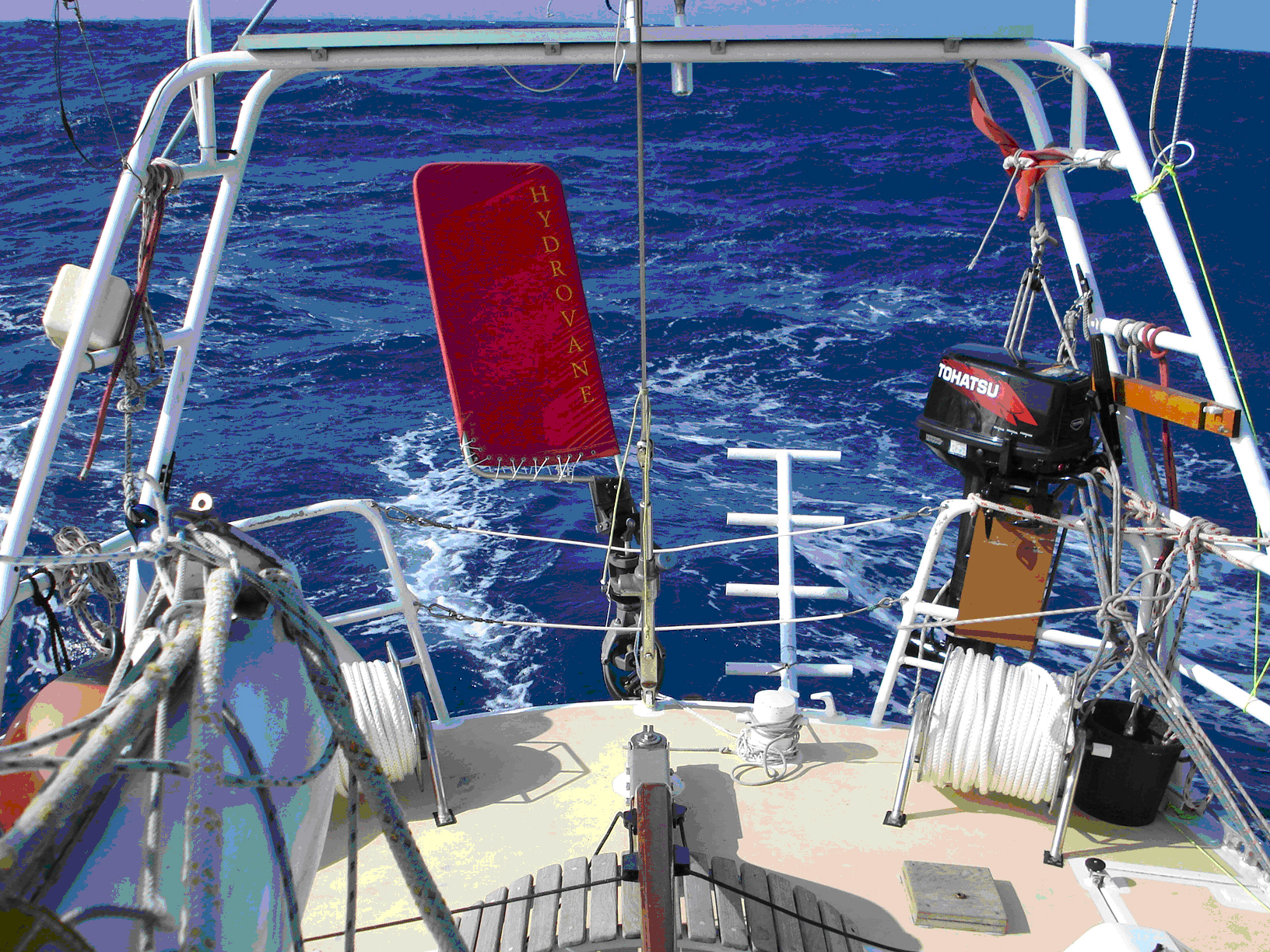
 Cal 39
Cal 39
“We departed last August, and the vane did an enormous amount of the steering down the coast to San Diego, then to Cabo as part of the Baja Haha, then back up to La Paz where the boat is now.”
“Gotta say it’s a spectacular piece of gear, and worked flawlessly the whole way.”
From: Edward Morgan
To: will@hydrovane.com
Subject: Edward Morgan. Cal 39
Hey, Will.
Seems a long time ago that we last chatted about installing the Hydrovane in my Cal in Seattle.
We departed last August, and the vane did an enormous amount of the steering down the coast to San Diego, then to Cabo as part of the Baja Haha, then back up to La Paz where the boat is now.
Gotta say it’s a spectacular piece of gear, and worked flawlessly the whole way. But in decommissioning the boat for summer storage, we notice a crack in the lower plastic ring. We have not touched it either in installation nor down the coast so I suspect it was either a bit over tightened when originally assembled or there was a flaw in the plastic somewhere.
[Editor’s note – The Bottom Collar is now available in stainless steel – no more cracking.]
Cheers
Ted Morgan
Contact Nicholson 32
Nicholson 32
“The gear performed as expected and we are very pleased.”
“…we are happy to have an extra crew signed on, especially one that does not need food and sleep!”
From: rya email
Sent: April-24-09 9:20 AM
To: John Curry
Subject: Hydrovane
Hi John
Yesterday we had our first sail in Kea with the new Hydrovane fitted. It was a perfect day for getting to know the gear, 15kts of wind and no sea. The gear performed as expected and we are very pleased. We are off on our summer cruise to Scotland soon and we are happy to have an extra crew signed on, especially one that does not need food and sleep!
I have one small comment about the fitting which was straightforward and that is that in your drawing of the Nicholson 32 stern the waterline shown is the designed waterline when in fact the boats float somewhat lower when fully loaded. I failed to spot this and as a result I fitted the gear is lower than I would have liked. With 2″ clearance between the bottom bracket and the bottom of the bearing tube the rudder shaft is immersed to the level of the hole for the locking pin and so the rudder is correspondingly lower in the water. This is not a major problem and if necessary I will raise the bottom bracket next winter.
[Editor’s note: As surmised, the height of the shaft is not important. Our only reason for the specified height is to keep the shaft out of the water – avoid growth. When raising it be sure to keep the bracket clamp well clear of the bottom bearing – not to pinch it. We suggest 2 inches of stainless tube showing – although it could be a bit less.]
Many thanks for a great piece of kit.
Best wishes
Chris
 Vancouver 32
Vancouver 32
“..it made little appreciable difference in reverse and if anything if improved in a go-forward aspect.”
“…as they say it does exactly what it says on the outside of the tin!”
Subject: Fantastic – First Time Out With Hydrovane
From: Paul Sellers
Date: Mon, April 20, 2009 6:28 am
————————————————————————–
What can I say it works flawlessly on any point viz. close to the wind, broad reaching or downwind it made no difference.
The other astounding feature precluding any need for anything like a tiller block is that we simply put the tiller in an upright vertical position (unlocked) and the Hydrovane did all the rest including tacking and a controlled gybe all simply by pulling the string. Incidentally on this latter point can the string be as short as you want or should it be of an ideal length we simply used it kite like yesterday with an end held in each hand.
Similarly Bill was absolutely right as far as leaving the rudder stock in and locked for an aft position when manoeuvring in the marina confines it made little appreciable difference in reverse and if anything if improved in a go-forward aspect.
Although so far only experienced for a few hours it does seem a marvelous piece of engineering and the set-up just works as they say it does exactly what it says on the outside of the tin!
Best wishes – Paul
In Paul’s research for a Hydrovane he discovered the owner of another Vancouver 32 who has had a Hydrovane for many years. The following is more of our dialogue with Paul including the response he got from ‘Jabril’:
From: Paul Sellers
Sent: December-04-08 6:45 AM
To: John Curry
Subject: FW: Hydrovane for Vancouver 32
Will and John
Thanks for these prompt responses I think my preference if only aesthetically is for a centreline installation such as Jabril’s but needless to say I now feel assured about the manoeuvrability question – indeed I am copying you with comments made by Jabril’s owner that only reinforce your own comments.
___________________________________
Hello Paul
Just caught up with all the various thoughts and advice coming your way re Hydrovane etc.
1/ the tube mountings around the rudder provide an exceptionally robust protection for your rudder in the marina and the Hydrovane is an exceptionally strong machine – things bounce off them!! (I never leave the auxiliary rudder in situ when moored up for any time – to stop erosion of the rudder shaft housing)
2/ the Hydrovane is amazingly sensitive in light airs, to the point that she will try to steer even when there is not enough wind to sail properly – in a reasonably heavy V32 that needs 10k+ of wind to get going at all. ( as mentioned before it all comes down to sail trim)
3/ Never had any problems in astern – especially with a CJR or Kiwi prop giving you proper reverse thrust. Have had some very difficult mooring manoeuvres (single-handed!) in Dingle marina that is even tighter than Falmouth. Also many tight mooring games with strong tidal cross flow – the Hydrovane rudder does not seem to influence the astern “nuances” of a V32 – but have always had a variable pitch prop to help overcome all the natural sambas of a long keel hull.
4/ If the boarding ladder gets in the way of the mounting, take it off and use the Hydrovane mounts as the ladder. I sometimes sit on the tube mounts to lift heavy things onboard etc. also easier to get in and out of dinghy as the mounts project further out over
the Avon side and you can simply step straight in.
Give us a call when you get back and we can meet up.
_________________________________
Okay so you’ve assured me of any concerns so what now of how to get an installation arranged vis a vis design of the fittings (Hydrovane to Boat) etc and ultimately the actual fitting/installation of the Hydrovane – indeed do you have anyone in Falmouth UK who you feel confident about and could take this on as a turnkey project? I’m not proposing to use the hull fitting as steps as John does if only hopefully to reduce the weight of his construction. Indeed, I’d much prefer the typical Hydrovane tubular fittings.
Again thank you for your quick responses it gives a good deal of comfort to work with obvious professionals.
Best wishes – Paul
 Nauticat 40
Nauticat 40
“The newly installed VXA 2D Hydrovane did the steering. I didn’t even bother to seatrial it before departure, knowing from your good self that it works on a NC40 ketch. I thought I’d work it out on the way. That took about 45 seconds.”
From: Steve – Offshore
Sent: Wednesday, March 11, 2009 3:55 PM
To: Ronald
Subject: Hydrovane
Hi Ronald,
Apologies for not replying sooner. Very busy and then thought I’d wait till I had some experience with it to report.
CHENG FENG arrived safely on 3rd March 2009 in Scarborough, Tobago after a 24 day passage from Gomera, Canary Islands . Single handed. The newly installed VXA 2D Hydrovane did the steering. I didn’t even bother to seatrial it before departure, knowing from your good self that it works on a NC40 ketch. I thought I’d work it out on the way. That took about 45 seconds.
It wasn’t the easy tradewind passage it’s supposed to be, we were beset by an almost continuous stream of showers and squalls, day and night. The wind varied in direction over the full NE quadrant and this created a cross sea most of the time. We sailed countless miles with seas on one quarter and the wind on the other, making for very difficult steering conditions. It was quite amazing to watch the Hydrovane deal with such conditions with only the apparent wind on the vane to control to.
I would recommend the VXA 2D Hydrovane to any NC40 ketch owner. As you say it gives you a nice peaceful ride, especially with no other crew on board.
I tried replying with this on the Nauticat group to something from you on Hydrovanes but it didn’t get through.
Best Regards,
Steve Burrows
NC40-054
CHENG FENG
Scarborough, Tobago


